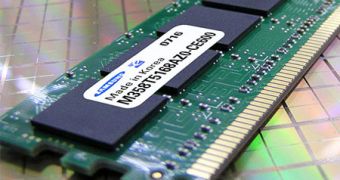Samsung Electronics Co., Ltd., the world leader in advanced memory technology, has recently announced having started the sampling of 50nm DDR3 memory modules. According to the company, this new advance will allow it to fabricate more power efficient memory modules, enabling it at the same time to produce devices with capacities of up to 16GB.
According to Samsung, the new 50nm samples are DDR3 modules featuring 2Gb capacity. The devices have been said to offer two times the density of the current 1Gb chips while also delivering 40 percent power efficiency over their predecessors. The company announced at the same time that the manufacturing of the 2Gb modules allows it to mark a 60 percent productivity gain.
“We have focused on maximizing density alternatives and power savings to make our 2Gb DDR3 solution as flexible as possible for designers,” said Jim Elliott, Vice President, Memory, Samsung Semiconductor, Inc. The 2Gb module is up to 1.6 times faster than an 800Mbps 1Gb-based dual-die package and also reduces heat emissions due to the smaller number of DDR3 chips.
The new form factor allows leveraged configurations, said the company. This way, registered in-line memory modules (RIMMs) can be configured with capacities of up to 8GB, while small outline dual in-line memory modules (SODIMMs), which are mainly designed for notebook usage, can rise to 4GB configurations. Desktop and server applications can gain even more capacity through the use of dual-die packages, which enables their densities to be leveraged to 16GB.
The new 2Gb devices are able to support data rates of up to 1.3 Gb/s at 1.5 or 1.35 volts, announced Samsung. The company stated that the mass production of the new 2Gb chips is planned to start by the end of this year, and also said that the 2Gb DDR3 should become its primary DRAM process technology in 2009. It is worth noticing that Samsung brought innovations to the industry starting with the introduction of the 150nm-class DRAM technology in 2000 and going to the mass volume production of 1Gb DDR2 under the 50nm-class process technology last April.
Samsung's announcement sounds more than attractive to enthusiasts, yet there are little chances for the mainstream computers to have the new 8GB or 16GB memory modules as an affordable option. Currently, 8 GB DDR3 devices are not too popular, and, at the same time, the similar DDR2 modules have prices well over $1,000.

 14 DAY TRIAL //
14 DAY TRIAL //